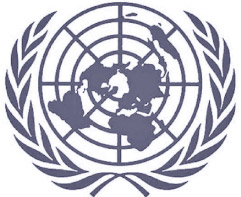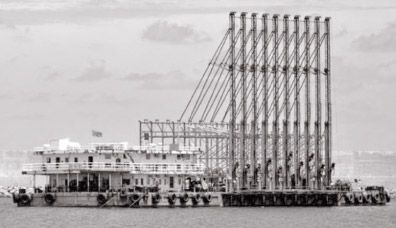Why super power covetousness for this tiny island?
 Major General Boniface Perera Major General Boniface Perera
RWP RSP ndu psc
Commander – Security Forces (Wanni) |
 Sri Lanka is an island with a land mass of 65,610 Sq km. Around 74
percent of the Sri Lankan population is Sinhalese and about 12.55 per
cent is Tamil; the majority who live in the North and the East of the
island and the rest is represented by few other communities (i.e.
Muslims and Malay). Sri Lanka is an island with a land mass of 65,610 Sq km. Around 74
percent of the Sri Lankan population is Sinhalese and about 12.55 per
cent is Tamil; the majority who live in the North and the East of the
island and the rest is represented by few other communities (i.e.
Muslims and Malay).
India with a population of over one billion people is the closest
neighbour of Sri Lanka which has only a population of 20 million.
However the Southern Indian Tamil population exceeds 60 million as
against 2 million Tamils in Sri Lanka. Proximity to Southern India and
the vast Tamil population in those states is a very crucial factor in
dealing with the subject of security in Sri Lanka.
Furthermore, Sri Lanka, located in the southern tip of India, lies at
the crossroads of all maritime routes in the region. About 70 per cent
of the global oil trade and 50 per cent of container traffic pass
through the Indian Ocean. Today, this sea route is operational with
36,000 ships passing through Sri Lanka’s southern port of Hambantota
annually, including 4,500 oil tankers. Sri Lanka is governed by a
Presidential system with the Judiciary, the Legislature and the
executive combining in the Governance process. It is an economically
booming region mainly due to the rapid development of two giants - India
and China.
For imperialists, our part of the Indian Ocean is not merely a market
to be conquered or a source of raw materials to be pillaged. It is the
gateway to the control of resources and markets in the Near East, Middle
East, Africa and Asia.
During the past few years, Sri Lanka appears to have forged closer
military relations with China. The rise of Chinese influence is
elsewhere in the Indian Ocean region (IOR) such as in Chittagong -
Bangladesh, Gwadar - Pakistan, and Kyaukpyu - Myanmar (Burma).
Consequently, news reports examining China’s bilateral relations with
Pakistan and Myanmar often make fleeting references to Sri Lanka’s
deepening ties with China in an attempt to establish a broader pattern
of Chinese activity in the IOR. Such reports about Sri Lanka and China
however are usually based on anecdotal accounts and speculation instead
of substantive data.
It is important to be aware of the geo- strategically, geo-political
and geo-social status of Southern India and North and East of Sri Lanka
to understand the sensitivity and complexity of the security situation
in Sri Lanka. The unique geographic position of Sri Lanka makes it a
natural aircraft carrier. In this background the resolution which has
been brought by the Americans led west against Sri Lanka at the 22nd
session of the UN Human Right Council needs to be examined very
carefully.
Humanitarian operation
Earlier, the UN had released a report on Sri Lanka’s decades-long war
with Tamil Tiger rebels, accusing both sides of actions which it says
led to the deaths of tens of thousands of civilians. It comes almost two
years after the government declared victory. The Darusman panel alleged
war crimes against Sri Lanka. It said there were "credible allegations,
which if proven, indicate that a wide range of serious violations of
international humanitarian law and international rights law was
committed both by the Government of Sri Lanka and LTTE some of which
would amount to war crimes and crimes against humanity". Furthermore,
this report says tens of thousands of civilians were killed in the final
phase of the war and that most of them died as a result of government
shelling. It also says hospitals, UN centres, ships belonging to the
international aid group and the Red Cross were deliberately targeted by
the Army. However, the report also accuses LTTE of using civilians as
human shields. However, Sri Lanka has rejected the report as biased and
fraudulent, and is conducting its own inquiry and asked the UN not to
publish the report, saying it could damage reconciliation efforts. It is
noteworthy to mention that the government’s “Zero casualty” policy
didn’t warrant military in using heavy weapons during the so called
final phase of the humanitarian operation.
During the war against LTTE and when Sri Lanka was on the verge of
victory, US-British lobbyists attempted at the UN Security Council to
secure a ceasefire at the end of the war. Both China and Russia usually
oppose foreign intervention in domestic conflicts, and both held off.
This provided freedom of action for Sri Lankan forces to achieve the
ultimate objective, of completely eradicating terrorism from Sri Lankan
soil. In my opinion, Sri Lanka’s achievement should have a positive
bearing on America’s ‘War on Terror’ policy.
Following the LTTE defeat in May 2009, the EU sought to pursue a
motion against Sri Lanka for war crimes investigations at the UN Human
Rights Council, which collapsed when 29 countries of the 47-member
council voted in solidarity with Sri Lanka.
Chinese investments
India itself came out strongly in support of Sri Lanka at the Council
and later even criticized the office of the United Nations High
Commissioner for Human Rights. Strong support extended by China and
Russia is noteworthy of mention.
 However the second motion which was brought by the American led West
against Sri Lanka on the same issue succeeded.It is important to
understand the geo-political and geo-strategical status-quo of the
world. However the second motion which was brought by the American led West
against Sri Lanka on the same issue succeeded.It is important to
understand the geo-political and geo-strategical status-quo of the
world.
After the collapse of the USSR the USA remains the sole super power.
Out of 196 countries in the world, Sri Lanka can claim no position in
terms of geo-strategic and geo-political importance and naturally draws
the attention of the Super power. On the one hand the USA is fearful and
worried about rising China as China is determined to be the World no 1
economy by the year 2020 and it seems that China is slowly but surely
marching towards the objective.
USA being the sole super power in the world would not tolerate and
wish to see China replacing the USA. In this context the USA seems to be
worried about the close friendship Sri Lanka is maintaining with China.
USA without much logical and valid reasons has jumped to that conclusion
and suspect Sri Lanka as a threat to American National Security.
Chinese investments have expanded rapidly, including in the
strategically situated commercial deep-sea port in Hambantota (US$1
billion) and a US$ 200 million international airport in Mattala and the
two-phase coal power plant in Norochcholai with nearly US$1.4 billion in
the north Western part of Sri Lanka. Some of the benefits enjoyed by Sri
Lanka are; the creation of US$28 million Mirigama exclusive economic
zone, US$ 248.2 million for building the Colombo Katunayake express
highway to hasten transportation between the country’s capital and the
international airport.
Sri Lanka has become an eager recipient of Chinese funds as China
does not impose any kind of preconditions like the West. As per May
2009, Times of London has noted that Chinese aid to Sri Lanka has jumped
from a few million dollars in 2005 to almost $1 billion in 2009
replacing Japan as the biggest foreign donor.
During the civil war in Sri Lanka, Beijing provided unconditional
diplomatic, economic and military support to the Sri Lankan government,
winning significant goodwill in Colombo. Indian threat perceptions have
grown as China has become more active in South Asia specially in the
construction of Sri Lanka’s southern port (Hambantota) which India fears
that China will use against it in the future by PLA (Navy). India is
worried that Sri Lanka is maintaining close links with China.
There is no valid reason for India to worry against Sri Lanka as Sri
Lanka has assured many times that it will never act against India’s
national security.
Though, experts are unable to rule out that Sri Lanka might someday
join hands with China, at this point, Colombo appears to be seeking
assistance from any country willing to provide the same as Sri Lanka is
a developing nation. Sri Lanka was not opposing China when it welcomed
arms to fight its civil war or financial loans to build projects like
the port in Hambantota. Sri Lanka is not bandwagoning against China, nor
is it using china to balance against the United States or India. The
United States is Sri Lanka’s top exporting country where Sri Lanka
sought as an investor in the Hambantota port. India is Sri Lanka’s
biggest source of imports and the first country given the option to
construct the Hambantota port. President Rajapaksa explains his
thinking: “Now take Hambantota port. It was offered to India first. I
was desperate for development work. But ultimately the Chinese agreed to
build it”. Although, this is the reality, US and Indian defense analysts
have pointed out that Hambantota will be used as a possible logistical
hub for future PLA Navy operations and shown their unhappiness. It
should be emphasized that Hambantota port was constructed only for
commercial purposes.
Militarily challenge
China’s neighbours are also sure to fear its rise, and they too will
do whatever they can to prevent it from achieving regional hegemony. In
fact, there is already evidence that countries like India, Japan, and
Russia, as well as smaller powers like Singapore, South Korea, and
Vietnam, are worried about China’s ascendancy and are looking for ways
to contain it. In the end, they will join a US-led balancing coalition
to check China’s rise, much the way Britain, France, Germany, Italy,
Japan, and even China joined forces with the USA to contain the Soviet
Union during the Cold War.
Infrastructure projects
In terms of international relations (IR) theory, this discussion is
rooted in John Mearsheimer’s take on structural realism – offensive
realism - which posits that China and the United States are inexorably
marching toward armed conflict due to underlying structural forces in
the international system. Mearsheimer argues that China will militarily
challenge the United States as its economic capabilities expand, as
rising powers such as World War II Japan have often done. He predicts
China will try regional hegemony in Asia, with some smaller Asian states
joining a balancing coalition led by the United States, because “the USA
does not tolerate peer competitors”.
 |
|
Magampura
Mahinda Rajapaksa Port |
According to Mearsheimer, the United States should be wary: “A rising
China is the most dangerous potential threat to the United States in the
early twenty-first century.” Whether, this theory becomes a reality or
not they fear that US might lose Sri Lanka to China in the future. It is
not irrational to mention that this tiny islanders will have to pay some
price as they are living in the most important strategic location on
earth which draws the attention of both regional and global powers.
From the US point of view, China’s increased determination to finance
various infrastructure projects in countries like Sri Lanka in the
Indian Ocean Region (IOR) for their future military advantages,
especially, Sri Lankan Hambantota harbour which can be used as a support
transiting base and as a surveillance station for PLA forces in the
future as defensive and offensive positions to protect energy interest
has irked the US. However, both china and Sri Lanka have rejected such a
motive. Furthermore, China’s most recent defense white paper does not
mention Sri Lanka at all, whereas it details military cooperation with
India.
However, In the event of war with the United States over Taiwan, for
example - Chinese policy planners have long feared a retaliatory US
Naval Blockade of the Strait of Malacca to cut off vital oil supplies.
In a 2003 speech, President Hu Jintao even acknowledged China’s
vulnerability in the Strait. Thus, some American security analysts have
argued that the People’s Republic of China (PRC) has been actively
constructing a “string of pearls” in the IOR to secure the safe passage
of oil by Chinese navy ships, as well as to position China as a
countervailing presence to US naval hegemony in the Sea Lines of
Communications (SLOC). Similarly, some Indian defense analysts believe
that China has launched a concerted effort to “encircle” India by moving
into the IOR, an area where China has historically not exercised a
sphere of influence.
US policymakers
Regardless of whether China has grand ambitions in the Indian Ocean,
Sri Lanka’s southern port Hambantota epitomizes Sri Lanka’s increasingly
robust relationship with China in recent years.
This deepening of Sri Lanka’s relations with China has resulted in
warnings from US policymakers that the United States “cannot afford to
‘lose’ Sri Lanka” - presumably to China - according to a December 2009
Senate Foreign Relations Committee report titled Sri Lanka’s growing
economic, military, and diplomatic ties with China.
Due to these strengthening connections, some American and Indian
observers have claimed, as discussed earlier, that Sri Lanka is
contributing to the “encirclement of India” or becoming a “pearl” in a
“string of pearls” for China in the IOR.
There is little doubt that Sri Lanka’s move to broaden relations with
China and Iran, its rejection of Western demands in its internal
affairs, the timing of its victory over the LTTE, and its acceptance in
June 2009 as a Dialogue Partner to the Shanghai Cooperation Organization
(SCO) were crucial in influencing the West’s attempts to take punitive
action against Sri Lanka.
After examining the available evidence, it should be noted that Sri
Lanka is neither bandwagoning nor balancing China as predicted by global
and regional power.
On the other hand, had Sri Lanka been located in a place like New
Zealand, so called human right violation issues would not have been
raised as New Zealand is not in a significant geographical location.
In this backdrop, US and European Union used the war crimes card
following the defeat of the LTTE simply to punish Sri Lanka for its
trade and diplomatic relations with Iran and China, and not out of any
great concern for human rights. In my frank opinion, if they were so
interested about human rights, the US and the West should have prevented
the genocide in Rwanda where one million or if not half a million people
were brutally killed in the conflict between two communities (Hutu and
Tutsi).
It should be emphasized that, Sri Lanka’s foreign policy is based on
Buddhism and compassion. Sri Lanka’s foreign policy is Friendship
towards all and enmity towards none. Furthermore, Sri Lanka is a non –
aligned nation which has no room to bandwagon with any power. In this
context, how can Sri Lanka be a threat to American National Security?
|







